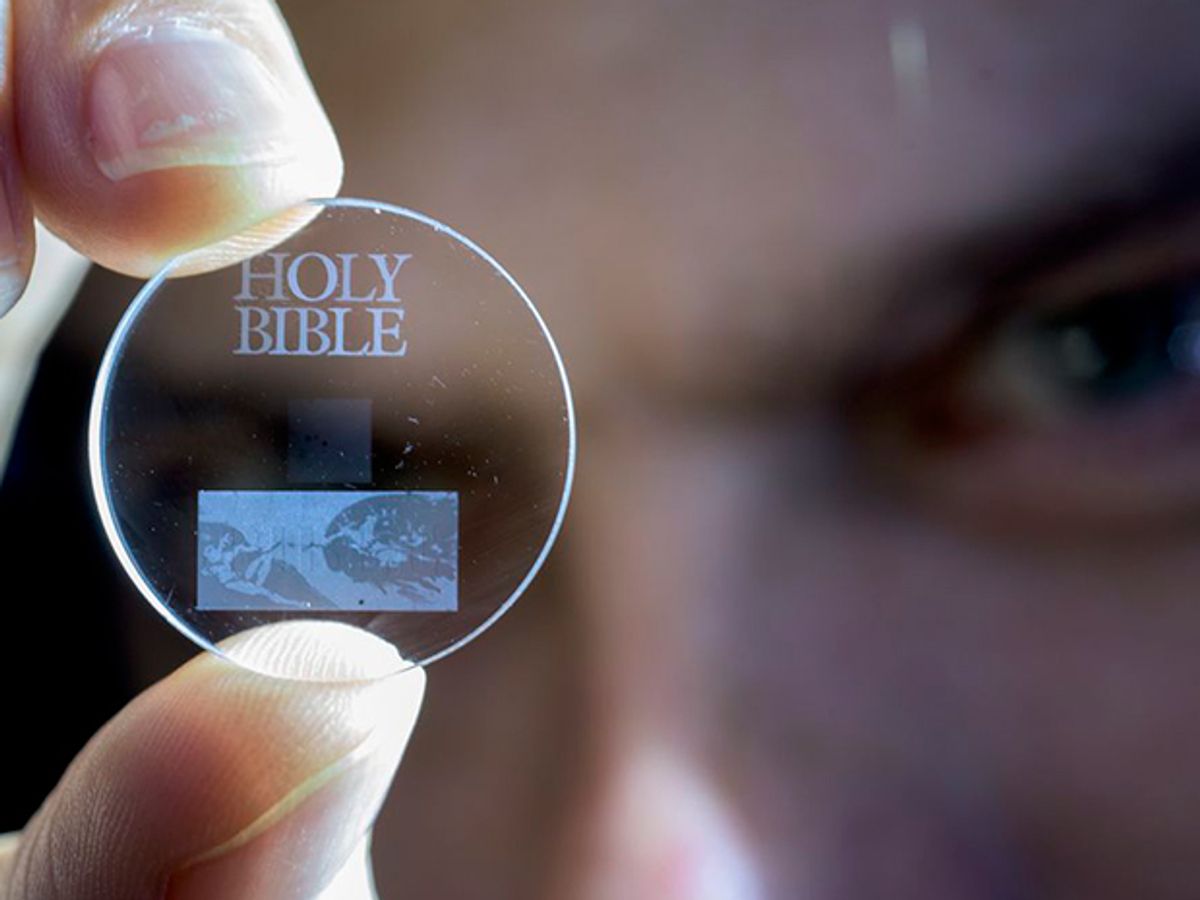Researchers in the UK have prototyped an ultimate data backup technology—a monocle-sized transparent disc that stores 360 terabytes, withstands fires and heat up to 1000º C and retains its data even over billions of years.
As IEEE Spectrum reported in 2013, the tiny quartz discs store their data as laser-etched nanostructures in the crystal. The nanostructures change the polarization of light passing through it. These changes are read off by an automated microscope algorithm that translates polarization signals back into the stream of stored data.
The system is called a “5D” data storage system, for the two extra dimensions (in addition to the standard three spatial dimensions) that polarization enables data to be encoded into the disc. And, says Peter Kazansky, professor at the Optoelectronics Research Centre at the University of Southampton, the idea began as a challenge.
As described in a 2011 paper, Kazansky’s group built a crystal structure that converts a beam of conventional (linearly) polarized light into a synchronized polarization state in which all the individual light rays inside the beam are oriented either radially like a pinwheel or azimuthally like a cyclone.
In a media interview at the time, Kazansky recalls, he was challenged to explain how this technology might be applied in a way that lay people might be able to appreciate.
The interviewer, Kazansky says, “could not understand how these converters could be used for [the] general public. … Then trying to convince him how it could be interesting, we told him this technology could also be used for optical recording.”
In a presentation at a recent optics conference, Kazansky detailed how his group went from concept in 2011 to working prototype today. Their earliest attempts at recording data on disc, he says, required more than a thousand laser pulses to record a single bit. The lasers, he says, are extremely fast, with pulses lasting less than a trillionth of a second. But, he says, it still represents a substantial speedup when the number of write pulses required per bit drops into the dozens.

“We are trying to understand the process and optimize reading and writing,” he says. “At the moment it’s 13 kilobits per second [write time]. And the read time I don’t know how to estimate it. I cannot tell you.”
This is because, he says, reading a document like the King James Bible—which his group has now recorded into 5D quartz alongside the Magna Carta, the UN Declaration of Human Rights and Isaac Newton’s book Opticks—requires multiple steps that can take varying amounts of time. The microscope must first photograph a section of the disc, and then the data reading algorithm translates that into zeros and ones.
In addition to speeding up the immortal bit writing process, Kazansky says they’ve been able to get their error rates down and read and write procedure streamlined.
“We now understand that we can record documents that are almost error free,” he says. “But still one of the issues is writing speed.”
Kazansky says he’s been fielding requests lately from unspecified big players in the digital world who are investigating the feasibility of archiving crucial data for permanent storage. His group’s most recent paper (yet unpublished) also speculates that “projects such as Time Capsule to Mars, Moon Mail, or Lunar Mission One could benefit from the extreme durability of data imprinted by femtosecond laser in quartz glass.”
The 5D quartz optical discs won’t be replacing industry standard archival optical discs (DVD or Blu-Ray) or even old-fashioned magnetic tape anytime soon. Those storage media may melt in a fire and turn to digital gibberish in just a few decades, but they can also be written to and read from quickly and without the intervention of microscopes and polarization-reading algorithms.
“At the moment, my personal interest in the direction of saving everything forever if possible,” Kazansky says. “I hope we will manage finally to solve the problem of the speed. Then obviously bigger markets will open.”
Margo Anderson is the news manager at IEEE Spectrum. She has a bachelor’s degree in physics and a master’s degree in astrophysics.



